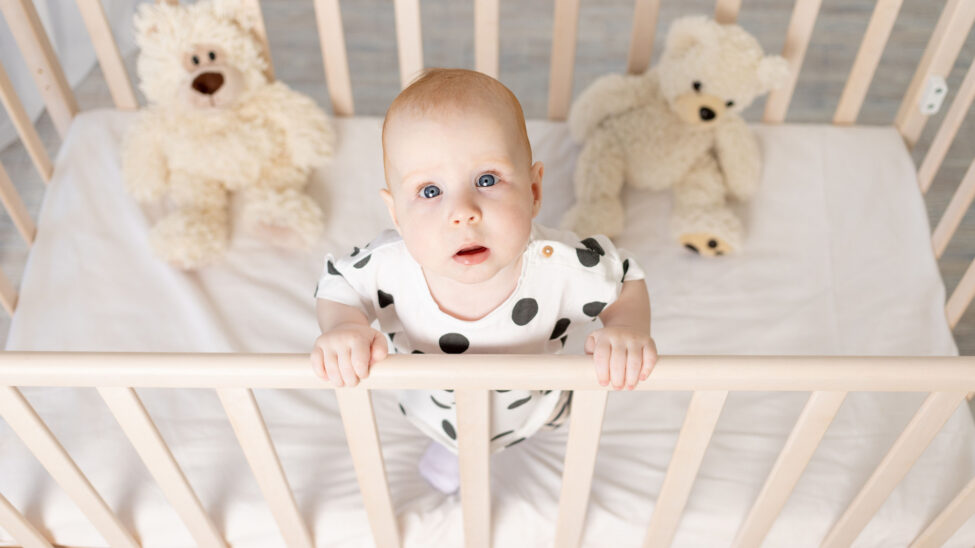
When the Crib Starts Whispering
It usually begins with a barely noticeable squeak. Then maybe a tiny wobble when you’re leaning in to pick up your baby half-asleep at 2 a.m. It’s easy to wave it off — sleep-deprived brains have more urgent matters. But if your crib is making itself heard, it’s worth pausing. Sometimes that squeak is your only warning sign before something goes from annoying to unsafe.
When my son Timofey was about ten months old, his crib started making a soft clicking sound near the base. I thought it was just the floor creaking. A week later, I noticed one of the slats had started shifting slightly. A screw had worked itself halfway out. It took five minutes and a screwdriver to fix it — but the what-ifs still make my stomach turn.
Even if the crib seems solid at a glance, small movements over time — especially with active babies — can loosen parts in ways you don’t notice until it’s too late.
Why It’s Not Just a Minor Issue
We often think of cribs as the safest place for a baby, and they are — when they’re fully intact. But even one loosened screw or unstable slat can create a gap or instability big enough to cause injury. Babies love to test their environment: pulling themselves up, shaking rails, even chewing the edges. That constant motion stresses the hardware.
What’s more, modern cribs are often made with easy-to-assemble parts, which, while convenient, can sometimes be prone to wear over time. Especially if you’ve disassembled and reassembled the crib during a move or transition to another room.
A misaligned joint or loosened fastener might look like nothing, but if a baby’s leg or arm slips into a gap, it could mean bruises — or worse.
One mom I worked with had twins and noticed that one corner of the crib was slightly lower than the rest. She assumed it was the floor. Turned out one of the support bolts had completely unscrewed itself under the mattress board. She caught it just in time.
The Calm Inspection Ritual
You don’t need a toolkit or a background in carpentry. Just your eyes, your hands, and five to ten minutes of undistracted attention. The key is consistency and knowing where to look. Set a reminder — maybe every two weeks — and make it part of your regular nursery reset.
Focus your inspection on:
- The mattress support frame: any visible gaps, warping, or loose bolts
- Side slats and rails: push gently to see if they wiggle or creak
- Screws and joints: run your fingers along them to feel for looseness
- Any moving mechanisms (like drop sides or rocking features): test for secure motion
Don’t rush. I often do this during nap time reset — when I’m tidying the room or refilling the diaper caddy. A slow walk around the crib with gentle nudges tells you more than you think. Listen for clicks. Watch for motion. Trust your gut — if something feels off, check it.
Fixing Without Overthinking
Found a screw halfway out? Don’t panic. Most of the time, all it takes is tightening it back into place. Keep a small set of tools — just a screwdriver and an Allen wrench — in a drawer nearby. That way, fixes become a 60-second task, not a production.
If you’ve lost a piece, check the crib’s brand website. Many offer replacements for specific parts. And if something feels unstable even after tightening, don’t hesitate to call their customer service. I once contacted a crib brand’s hotline after a locking wheel wouldn’t engage fully. They sent me a new part the same week — no charge.
Staying on top of small fixes keeps them from becoming big problems. And it gives you peace of mind, which every tired parent needs more than anything.
A Habit That Feels Like Care
Crib inspections aren’t about paranoia. They’re about protecting the calm you’ve worked so hard to create. The more familiar you are with your baby’s sleep space, the quicker you’ll catch the little shifts that might signal something bigger.
For me, it’s become a quiet moment — checking the corners while I hum a lullaby, feeling the mattress board as I straighten the sheets. It’s not a chore. It’s a gesture. A way of saying, “I’ve got you, little one.”
If you share childcare with a partner, take turns or do it together during a weekend reset. The habit builds connection too. One dad I worked with turned it into a ritual with his toddler, pretending to be “crib detectives” every Sunday evening.
Safety isn’t just about rules. It’s about rhythms — the small, caring routines that build trust and let everyone sleep a little easier.


